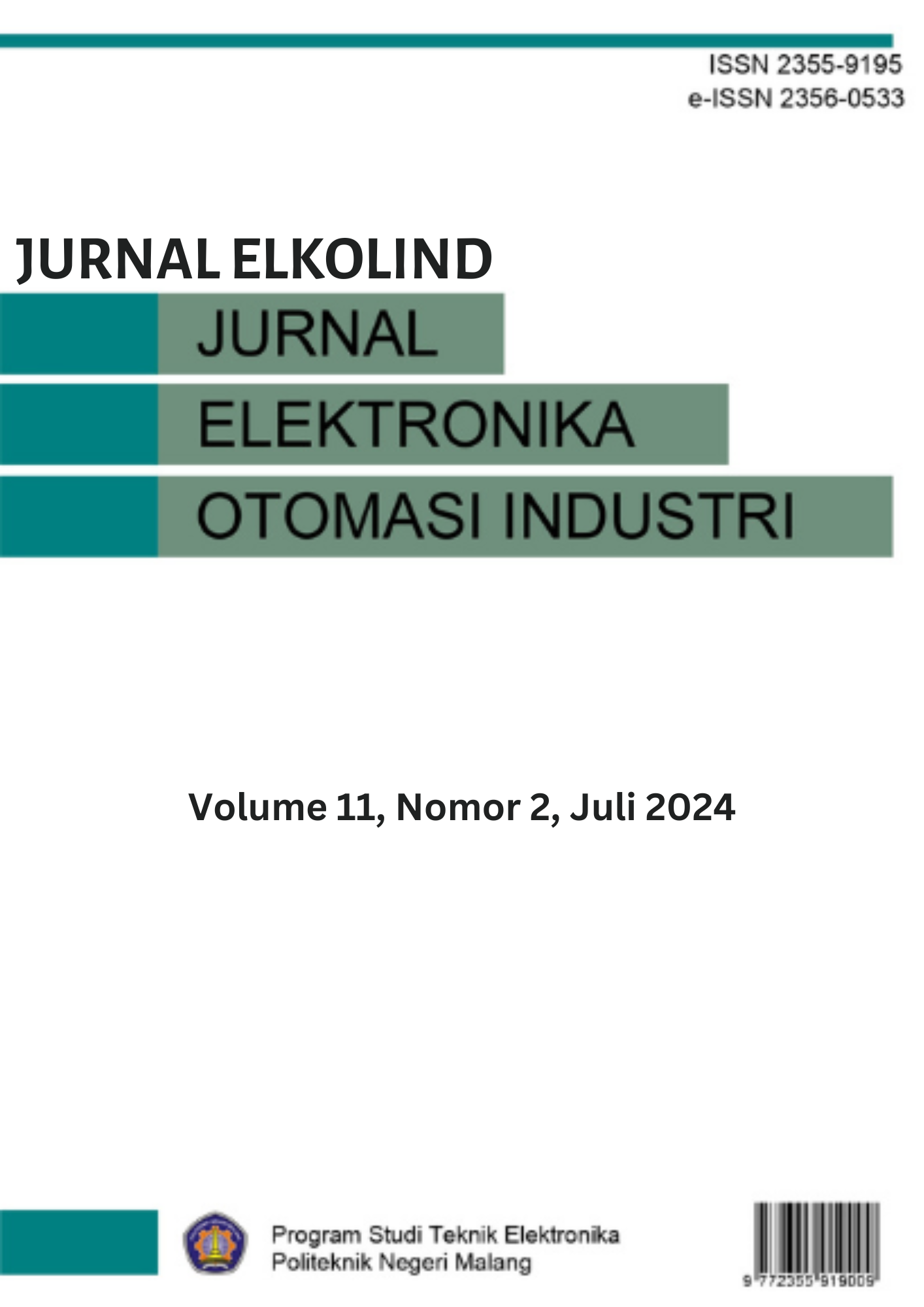Main Article Content
Abstract
Artikel ini membahas perancangan solder reflow model plat berbasis fuzzy. Untuk menggunakan solder ini, pasta dan komponen dipasang pada PCB lalu PCB diletakkan diatas heater plat yang suhunya terkontrol fuzzy pada ruang terbuka. Masalah utama solder reflow adalah bagaimana menghasilkan pemanasan yang berubah-ubah sesuai profil penyolderan. Kontroller solder reflow mentracking setpoint suhu yang berubah menurut waktu, terdiri atas fase pemanasan awal, pelelehan, dan pendinginan. Kontroler Fuzzy dirancang menggunakan ESP32 dan library eFFL yang memiliki 2 input (error dan delta-error suhu), 5 keanggotaan error, 5 keanggotaan delta-error, 5 keanggotaan output, 25 rule inferensi, fuzzifikasi Mamdani dan defuzzifikasi CoA. Sensor suhu berupa termocouple tipe K dan pengondisi sinyal MAX6675. Aktuator berupa heater 1000W dan kipas AC 8x8x2,5cm, masing-masing digerakkan menggunakan driver dimmer (TRIAC). ESP32 dilengkapi program management profil penyolderan (CRUD) yang dioperasikan melalui rotary encoder KY040 dan display OLED 128x64 0.96inch. Unjuk kerja solder reflow dinilai berdasarkan rata-rata error suhu dan kualitas hasil penyolderan rangkaian flipflop melalui 2 profile penyolderan. Eksperimen yang dilakukan terhadap 5 sample memberikan hasil error suhu rata-rata sebesar 5,3%, hasil solderan baik (tanpa cacat penyolderan) dan rangkaian flipflop hasil penyolderan berfungsi normal.
Keywords
Article Details
Copyright (c) 2024 Reza Bagas Kurnia, Sidik Nurcahyo, Eka Mandayatma

This work is licensed under a Creative Commons Attribution 4.0 International License.
References
- Dicoding, “Apa Itu Prototype? Kenapa Itu Penting? - Dicoding Blog,” Jul. 01, 2022. https://www.dicoding.com/blog/apa-itu-prototype-kenapa-itu-penting/ (accessed Jun. 28, 2023).
- B. Salam, C. Virseda, H. Da, N. N. Ekere, and R. Durairaj, “Reflow profile study of the Sn‐Ag‐Cu solder,” Soldering & Surface Mount Technology, vol. 16, no. 1, pp. 27–34, Jan. 2004, doi: 10.1108/09540910410517022.
- W. T. Wahono, T. Winarno, and F. Fathoni, “Implementasi Fuzzy Logic untuk Pengontrolan Suhu pada Proses Reflow Oven Soldering,” Jurnal Elektronika dan Otomasi Industri, vol. 3, no. 1, p. 2, Nov. 2020, doi: 10.33795/ELKOLIND.V3I1.59.
- A. Nur Fajrin, D. Darlis, and R. Ardianto Priramadhi, “Alat Reflow Soldering Dengan Pengaturan Suhu Reflow Soldering Tool With Temperature Control,” 2020.
- S. Jing, M. Li, X. Li, and P. Yin, “Optimization of reflow soldering temperature curve based on genetic algorithm,” Energy Reports, vol. 7, pp. 772–782, Nov. 2021, doi: 10.1016/J.EGYR.2021.09.195.
- Electronoobs, “Homemade Reflow Hot plate for SMD components with Arduino,” Jul. 01, 2022. http://electronoobs.com/eng_arduino_tut155.php (accessed Jun. 28, 2023).
- G. Ulpiani, M. Borgognoni, A. Romagnoli, and C. Di Perna, “Comparing the performance of on/off, PID and fuzzy controllers applied to the heating system of an energy-efficient building,” Energy Build, vol. 116, pp. 1–17, Mar. 2016, doi: 10.1016/J.ENBUILD.2015.12.027.
- [8] P. Mondal and M. Mondal, “Engineering and Technology (A High Impact Factor,” International Journal of Innovative Research in Science, vol. 7, 2018, doi: 10.15680/IJIRSET.2018.0707013.
- Ablic, “Resistance to soldering heat condition for Package – ABLIC Inc.,” Jul. 01, 2022. https://www.ablic.com/en/semicon/support/package/solder-temp-profile/ (accessed Jun. 28, 2023).
- Iconnect007, “The Benefits of a Ramp-to-Spike Reflow Profile,” Jul. 30, 2022. http://smt.iconnect007.com/index.php/article/51868/the-benefits-of-a-ramp-to-spike-reflow-profile/51871/?skin=smt#:~:text=RTS%20has%20several%20advantages%20over,vehicle%20throughout%20the%20preheat%20stage. (accessed Jun. 28, 2023).
- K. Dušek, D. Bušek, P. Veselý, A. Pražanová, M. Plaček, and J. Del Re, “Understanding the Effect of Reflow Profile on the Metallurgical Properties of Tin–Bismuth Solders,” Metals (Basel), vol. 12, no. 1, p. 121, Jan. 2022, doi: 10.3390/MET12010121/S1.
- E. H. Amalu, Y. T. Lui, N. N. Ekere, R. S. Bhatti, and G. Takyi, “Investigation Of The Effects Of Reflow Profile Parameters On Lead‐free Solder Bump Volumes And Joint Integrity,” AIP Conf Proc, vol. 1315, no. 1, pp. 639–644, Jan. 2011, doi: 10.1063/1.3552519.
References
Dicoding, “Apa Itu Prototype? Kenapa Itu Penting? - Dicoding Blog,” Jul. 01, 2022. https://www.dicoding.com/blog/apa-itu-prototype-kenapa-itu-penting/ (accessed Jun. 28, 2023).
B. Salam, C. Virseda, H. Da, N. N. Ekere, and R. Durairaj, “Reflow profile study of the Sn‐Ag‐Cu solder,” Soldering & Surface Mount Technology, vol. 16, no. 1, pp. 27–34, Jan. 2004, doi: 10.1108/09540910410517022.
W. T. Wahono, T. Winarno, and F. Fathoni, “Implementasi Fuzzy Logic untuk Pengontrolan Suhu pada Proses Reflow Oven Soldering,” Jurnal Elektronika dan Otomasi Industri, vol. 3, no. 1, p. 2, Nov. 2020, doi: 10.33795/ELKOLIND.V3I1.59.
A. Nur Fajrin, D. Darlis, and R. Ardianto Priramadhi, “Alat Reflow Soldering Dengan Pengaturan Suhu Reflow Soldering Tool With Temperature Control,” 2020.
S. Jing, M. Li, X. Li, and P. Yin, “Optimization of reflow soldering temperature curve based on genetic algorithm,” Energy Reports, vol. 7, pp. 772–782, Nov. 2021, doi: 10.1016/J.EGYR.2021.09.195.
Electronoobs, “Homemade Reflow Hot plate for SMD components with Arduino,” Jul. 01, 2022. http://electronoobs.com/eng_arduino_tut155.php (accessed Jun. 28, 2023).
G. Ulpiani, M. Borgognoni, A. Romagnoli, and C. Di Perna, “Comparing the performance of on/off, PID and fuzzy controllers applied to the heating system of an energy-efficient building,” Energy Build, vol. 116, pp. 1–17, Mar. 2016, doi: 10.1016/J.ENBUILD.2015.12.027.
[8] P. Mondal and M. Mondal, “Engineering and Technology (A High Impact Factor,” International Journal of Innovative Research in Science, vol. 7, 2018, doi: 10.15680/IJIRSET.2018.0707013.
Ablic, “Resistance to soldering heat condition for Package – ABLIC Inc.,” Jul. 01, 2022. https://www.ablic.com/en/semicon/support/package/solder-temp-profile/ (accessed Jun. 28, 2023).
Iconnect007, “The Benefits of a Ramp-to-Spike Reflow Profile,” Jul. 30, 2022. http://smt.iconnect007.com/index.php/article/51868/the-benefits-of-a-ramp-to-spike-reflow-profile/51871/?skin=smt#:~:text=RTS%20has%20several%20advantages%20over,vehicle%20throughout%20the%20preheat%20stage. (accessed Jun. 28, 2023).
K. Dušek, D. Bušek, P. Veselý, A. Pražanová, M. Plaček, and J. Del Re, “Understanding the Effect of Reflow Profile on the Metallurgical Properties of Tin–Bismuth Solders,” Metals (Basel), vol. 12, no. 1, p. 121, Jan. 2022, doi: 10.3390/MET12010121/S1.
E. H. Amalu, Y. T. Lui, N. N. Ekere, R. S. Bhatti, and G. Takyi, “Investigation Of The Effects Of Reflow Profile Parameters On Lead‐free Solder Bump Volumes And Joint Integrity,” AIP Conf Proc, vol. 1315, no. 1, pp. 639–644, Jan. 2011, doi: 10.1063/1.3552519.
